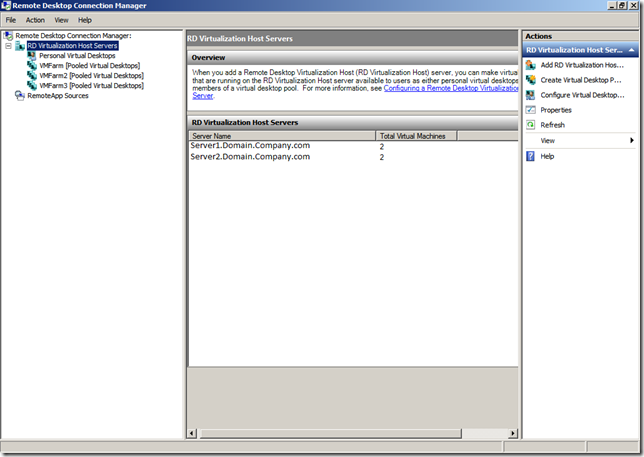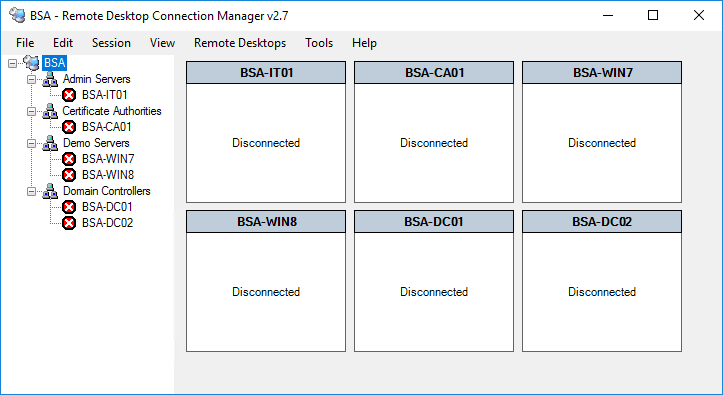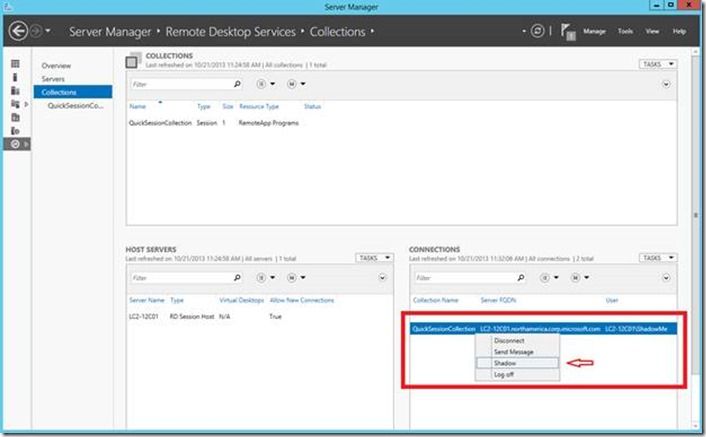
Applies to: Windows Server (Semi-Annual Channel), Windows Server 2019, Windows Server 2016

As an admin, you can directly manage which users have access to specific collections. This way, you can create one collection with standard applications for information workers, but then create a separate collection with graphics-intensive modeling applications for engineers. There are two primary steps to managing user access in a Remote Desktop Services (RDS) deployment:
Create your users and groups in Active Directory
RDCMan is a central place where you can organize, group, and manage your various Remote Desktop connections. This is particularly useful for system administrators, developers, testers, and lab managers who maintain groups of computers and connect to them frequently. As an example - my customer manages over 200 Exchange servers worldwide. On the Windows start screen, click the Server Manager tile. To start Server Manager from the Windows desktop. On the Windows taskbar, click Server Manager. To prevent Server Manager from starting automatically. In the Server Manager console, on the Manage menu, click Server Manager Properties. Microsoft Remote Desktop Connection Manager (RDCMan) Like other tools, it can save login credentials, so you don’t need to enter your credentials every time you want to create a remote connection. RDCMan also supports connections between virtual machines and consoles, allows you to establish smart groups, and gives you the ability to import. Download Remote Desktop Manager - Remote Desktop Manager (RDM) centralizes all remote connections on a single platform that is securely shared between users and across the entire team.
In Remote Desktop Connection, type the name of the PC you want to connect to (from Step 1), and then select Connect. On your Windows, Android, or iOS device: Open the Remote Desktop app (available for free from Microsoft Store, Google Play, and the Mac App Store), and add the name of the PC that you want to connect to (from Step 1).
In an RDS deployment, Active Directory Domain Services (AD DS) is the source of all users, groups, and other objects in the domain. You can manage Active Directory directly with PowerShell, or you can use built in UI tools that add ease and flexibility. The following steps will guide you to install those tools — if you do not have them already installed — and then use those tools to manage users and groups.
Install AD DS tools
The following steps detail how to install the AD DS tools on a server already running AD DS. Once installed, you can then create users or create groups.
- Connect to the server running Active Directory Domain Services. For Azure deployments:
- In the Azure portal, click Browse > Resource groups, and then click the resource group for the deployment
- Select the AD virtual machine.
- Click Connect > Open to open the Remote Desktop client. If Connect is grayed out, the virtual machine might not have a public IP address. To give it one perform the following steps, then try this step again.
- Click Settings > Network interfaces, and then click the corresponding network interface.
- Click Settings > IP address.
- For Public IP address, select Enabled, and then click IP address.
- If you have an existing public IP address you want to use, select it from the list. Otherwise, click Create new, enter a name, and then click OK and Save.
- In the client, click Connect, and then click Use another account. Enter the user name and password for a domain administrator account.
- Click Yes when asked about the certificate.
- Install the AD DS tools:
- In Server Manager click Manage > Add Roles and Features.
- Click Role-based or feature-based installation, and then click the current AD server. Follow the steps until you get to the Features tab.
- Expand Remote Server Administration Tools > Role Administration Tools > AD DS and AD LDS Tools, and then select AD DS Tools.
- Select Restart the destination server automatically if required, and then click Install.
Create a group
You can use AD DS groups to grant access to a set of users that need to use the same remote resources.
- In Server Manager on the server running AD DS, click Tools > Active Directory Users and Computers.
- Expand the domain in the left-hand pane to view its subfolders.
- Right-click the folder where you want to create the group, and then click New > Group.
- Enter an appropriate group name, then select Global and Security.
Create a user and add to a group
- In Server Manager on the server running AD DS, click Tools > Active Directory Users and Computers.
- Expand the domain in the left-hand pane to view its subfolders.
- Right-click Users, and then click New > User.
- Enter, at minimum, a first name and a user logon name.
- Enter and confirm a password for the user. Set appropriate user options, like User must change password at next logon.
- Add the new user to a group:
- In the Users folder right-click the new user.
- Click Add to a group.
- Enter the name of the group to which you want to add the user.
Assign users and groups to collections
Now that you've created the users and groups in Active Directory, you can add some granularity regarding who has access to the Remote Desktop collections in your deployment.
Connect to the server running the Remote Desktop Connection Broker (RD Connection Broker) role, following the steps described earlier.
Add the other Remote Desktop servers to the RD Connection Broker's pool of managed servers:
- In Server Manager click Manage > Add Servers.
- Click Find Now.
- Click each server in your deployment that is running a Remote Desktop Services role, and then click OK.
Edit a collection to assign access to specific users or groups:
- In Server Manager click Remote Desktop Services > Overview, and then click a specific collection.
- Under Properties, click Tasks > Edit properties.
- Click User groups.
- Click Add and enter the user or group that you want to have access to the collection. You can also remove users and groups from this window by selecting the user or group you want to remove, and then clicking Remove.
Note
The User groups window can never be empty. To narrow the scope of users who have access to the collection, you must first add specific users or groups before removing broader groups.
Looking for Windows 10 remote desktop manager software to remotely access another computer? Here’s free remote desktop connection manager for Windows 10 PC.
There are times when we want to take control of our friend’s computer or remotely access another computer when we are not able to go there physically.
Remote Desktop Connection is a very popular technology developed by the Microsoft using which users can remotely connect to another Windows computer over a network connection. In simple words, Remote Desktop is a separate program or an operating system feature that allows users to connect to a computer in another location and access that computer’s desktop.
Let’s say, you are living in India and want to access the computer of your friend who is residing in the United States. The first option which you are having at this point is to book a ticket to the United States, reach your friend’s home and use his computer or you can simply use remote desktop connection manager for the same. The first option is not only going to cost you a lot of money but will also take a toll on your time. In this situation, using the remote computer access feature or remote desktop connection manager software to remotely access another computer is the most appropriate option for you.
In order to use Remote Desktop Protocol (RDP), you need a remote desktop connection manager which is responsible for all the Remote connections you are making. Remote desktop protocol comes with a very user-friendly interface which makes it very easy for the user to create a remote connection and set up computer for remote access.
You can even use your keyboard, mouse to access all features of the device whose remote connection you are taking. This free remote access feature is available by default in all versions of Windows operating system as RDP is owned by the Microsoft.
If you are having a good remote desktop connection manager software, you can manage multiple remote desktop connections /sessions easily without any difficulty or interruption.
For some peoples, selecting the best remote desktop software for Windows computer is really a very tough task because there are plenty of free remote desktop management software and computer remote software available on the Web. This is the main reason that today we are going to explain about the top 7 best remote desktop connection manager programs which you can use on your Windows 10 computers.

Top 7 Best Free Remote Desktop Connection Manager for Windows 10
This remote desktop software guide is specially created for the Microsoft Windows 10 operating system users. So, if you are looking for the best free Windows 10 remote desktop connection manager or Windows 10 home remote desktop manager software to set up and allow remote connections on the computer you want to connect to then you are at the absolutely right place.
The best remote desktop connection manager software comes not only with the management of multiple remote connections but also allows users to use several other protocols like HTTP, FTP, SSH etc. The interesting thing is, all the remote computer access software mentioned below can be downloaded for free from their official websites. It means, there is no need to spend a single penny on remote desktop connection managers.
So, are you ready to check out the list of best free remote desktop connection manager software to remotely access another computer over the same network or to the Internet? Here we go.
Remote Desktop Connection Manager 2.7
If you want to manage multiple remote desktop connections then using Remote Desktop Connection Manager 2.7 developed by the Microsoft is the best option for you.
RDCMan manages multiple remote desktop connections and it is quite useful for managing server labs or large server farms. This remote desktop manager is not only compatible with Windows 10 operating system but also works pretty well on Windows XP, Windows Server 2003 and Windows 7 etc. However, if you want to use this Windows remote desktop connection tool on Windows XP make sure that you are having the latest version of this tool.
You can download and use Windows Remote Desktop Connection Manager 2.7 for free on your Windows 10 computers. Check out this Remote Desktop Connection tutorial to know in details about allowing remote connections on the computer you want to connect to.
Remote Desktop Manager
Remote Desktop Manager is one of the best remote desktop connection managers which allow you to manage multiple remote sessions which you are taking from your computer. Along with the remote sessions, you can also manage other network protocols using this remote access program like Putty, HTTP, LogMeIn etc.
The user database is encrypted with AES protection which ensures that all the login details are safe from hackers. You can integrate Remote Connection Manager with many services as it comes with Intel AMT, Windows PowerShell support, and an advanced Hyper-V dashboard.
If you are looking for the fastest remote access Windows 10 software which will do a lot more than only managing remote connections then Remote Desktop Manager – remote connection and password management software is the best free remote access tool you need to use.
Terminals
Terminals is a secure remote desktop client and very feature rich software which is compatible with Windows 10, Windows 8, Windows 7, and Windows XP operating systems. Managing remote connections with Terminals is extremely easy as it is a multi-tab terminal remote access Windows 10 service.
Terminals uses Terminal Services Active client which is a service running on Windows computers. Along with management of Windows remote desktop (RDP) connections, Terminals is a great remote access tool which works well with VNC, VMRC, SSH, Telnet, RAS, ICA Citrix, HTTP and HTTPs based viewers.
If you are into networking then you can take benefit of this tool as it handles protocols like Trace Route, Ping, TCP connections and much more. The open source project is working well from the last few years. Terminals is available both in 32-bit versions and 64-bit versions and as it is an open source remote desktop connection manager software, so you can download and use it for free of cost.
MultiDesk
If you are looking for a tab based remote connection manager then you should MultiDesk terminal services client. The tab structure of this Windows 10 remote desktop software makes management of multiple remote connections very easy. You can manage the remote connections through group or server folder without any difficulty.
One of the best things about MultiDesk is that it is not only free but portable and SSD/flash drive friendly too which means that you don’t have to install it on your computer, simply download it and you are ready to manage multiple remote desktop connections on your Windows 10 computer.
MultiDesk tabbed remote desktop client is perfectly compatible with Microsoft Remote Desktop Connection (Terminal Services Client) 6.0 or higher, Windows 10, Windows 8, Windows 7, 2012, 2008, VISTA, 2003, and Windows XP operating system. If you were looking for a very simple and convenient remote desktop service to set up computer for remote access then MultiDesk is the right choice for you.

RD Tabs
The next best free remote desktop connection manager for Windows which makes to our list is RD Tabs. This is another powerful tab based Windows 10 remote desktop tool. RD Tabs – The Ultimate Remote Desktop Client comes with user-friendly interface which makes it easy even for a novice to use it as it is not complex at all.
There are many amazing features available in this remote computer access tool such as advanced editing, connection thumbnails, command line scripting, detached connection Windows support, remote terminal server information, remote desktop screen capture and much more.
We really liked the remote desktop capture feature as it allowed us to capture the screen of the remote sessions which we were taking. If you are looking for easy to use free remote access software which comes with user-friendly interface then you ought to use RD Tabs remote desktop manager. It requires the .Net Framework 2.0. Enjoy free download RD Tabs software to remotely access another computer over the same network.
mRemoteNG

mRemoteNG (Multi-Remote Next Generation) was earlier known as mRemote and is an open source remote desktop software which allows great remote sessions management which one is taking from his host computer. You can easily take access of multiple protocols as mRemoteNG is a multi-protocol remote desktop software.
RDP (Remote Desktop/Terminal Server), VNC (Virtual Network Computing), ICA (Citrix Independent Computing Architecture), SSH (Secure Shell), Telnet (TELecommunication NETwork), HTTP/HTTPS (Hypertext Transfer Protocol), rlogin, and Raw Socket Connections etc. are some of the popular protocols supported by the mRemoteNG.
Just like other remote desktop connection manager alternatives and free remote access software, you are going to get a tabbed interface which makes taking remote sessions easy and management a swift task. Download mRemoteNG remote connections manager enjoy a hassle-free remote access Windows 10 computer.
Parallels Remote Application Server
Rdp Management Tool
We have reached the end of our remote access software list and Parallels Remote Application server is the multitasking computer remote software which can be used for managing all the remote sessions which you are taking.
Parallels Remote Application Server (RAS) was available for only Windows 7 and Windows 8 and now you can use it on your Windows 10 computers too. Managing remote connections is very simple with this tool as it comes with user-friendly interface, so if you have not used computers a lot, you don’t need to worry.
You can even check the help section of this easy to use, flexible, and secure open source remote support software which is filled with articles and how-to guides of operating this tool with ease. You can download and use Parallels Remote Application Server for free.
Conclusion
Microsoft Rdp Manager Windows 10
If you are taking multiple remote sessions from your machine it can be really difficult to manage them. Management of multiple remote connection sessions is very easy with these best free remote desktop connection manager for Windows 10 PC. All the Windows 10 remote desktop managers which we have shared in this guide work pretty well and as they are available for free so anyone can use them.
We have been using Remote Desktop connection Manager 2.7 from a while now and personally find it best, but hey choices differ from person to person so it is normal that you go with any other free remote access software.
Which remote desktop manager or remote computer access software are you using on your Windows 10 computer for managing all the remote sessions? Did we miss to mention any popular and best remote desktop connection managers? Let us know using the comments section below.
You may also be interested in checking out these Windows 10 Software guides:
